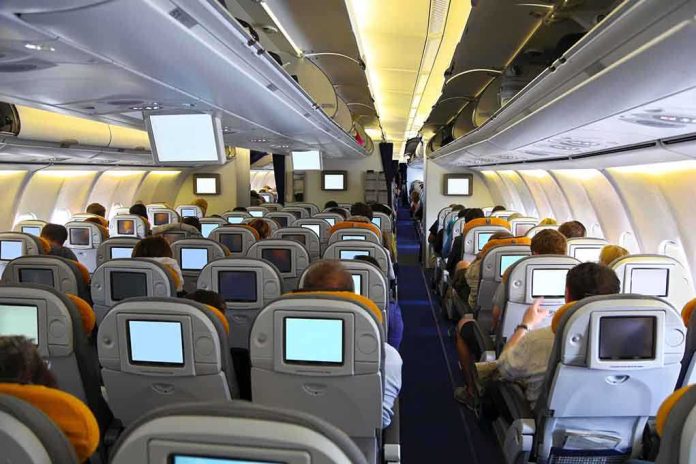
When an American Airlines jet packed with passengers and crew suddenly turned back to Los Angeles, the real story wasn’t the sickening fumes—it was a glimpse into aviation’s hidden battle over the air we all breathe at 30,000 feet.
Story Snapshot
- American Airlines Flight 274 returned to LAX after passengers and crew reported alarming fumes shortly after takeoff.
- Pilots donned oxygen masks; emergency responders met the plane, but no hazardous substances were found.
- The incident follows a similar Delta Airlines event, fueling growing concerns about cabin air quality and airline safety protocols.
- Despite extensive inspections and no detected danger, questions linger over what really happened in the cabin—and what it means for future flights.
Passengers and Crew Caught in a Sudden Air Emergency
American Airlines Flight 274 left Los Angeles for New York with a routine promise of cross-country travel. A few minutes after takeoff, that promise evaporated. Passengers and crew began to sense a strong odor, described as sickening and unfamiliar. Within moments, some reported feeling ill. The pilots tasted the fumes and made the split-second decision to don oxygen masks, signaling a full-scale emergency in the cockpit and cabin. The aircraft looped back and landed at LAX, met by a coordinated response of firefighters and medical staff. Seven passengers were evaluated on the tarmac, but none required hospitalization. The jet was taken out of service for inspection, its journey interrupted by a mystery that left travelers shaken and the public asking questions.
The immediate drama may have ended on the ground, but the implications stretched far beyond the runway. No hazardous substances were detected in the cabin, and American Airlines quickly issued a public apology, assuring passengers that their safety was paramount and promising a thorough investigation. Passengers were rebooked on another flight, but the incident left an unsettling uncertainty: if nothing dangerous was found, what caused the symptoms and the strong odor? And could it happen again?
Airline Industry Faces Scrutiny Over Cabin Air Quality
This event wasn’t an isolated anomaly. Earlier that same week, a Delta Airlines flight had to return to Heathrow because of smoke in the cockpit, underscoring an unnerving pattern of “fume events” in commercial aviation. Such incidents have plagued airlines for decades, often traced to oil fumes, smoke, or other contaminants entering ventilation systems. These events are rarely catastrophic but frequently disruptive, raising both health concerns and regulatory flags. The frequency of reports is increasing, and passenger anxiety is growing louder. Industry watchers note that the real battle is over how airlines detect, report, and respond to air quality emergencies. The rapid response from American Airlines and emergency services in this case demonstrates operational preparedness, but the inability to pinpoint a cause after thorough inspection highlights gaps in the current system.
Regulatory agencies like the FAA may investigate, but airlines hold most of the operational authority during emergencies. The flight crew, acting as first responders, have situational command and must make split-second decisions. Passengers, though largely powerless in the moment, can influence public perception and regulatory action through complaints and viral media coverage. The incident’s media exposure ensures that airlines and regulators will be pressed for more answers, more transparency, and better preventive measures.
Rising Stakes: Health, Safety, and the Future of Flying
The consequences of these incidents extend beyond the inconvenience of a disrupted itinerary. In the short term, passengers face delays and anxiety, while airlines contend with operational headaches, compensation claims, and reputational risks. The long-term effects could be far more significant. Regulatory scrutiny is likely to intensify, potentially leading to new standards for air filtration, detection, and reporting. The airline industry, already under post-pandemic pressure, may need to invest in improved technology and training to prevent future incidents and restore passenger confidence.
Aviation safety experts emphasize that while “fume events” are rare, their seriousness demands robust protocols and transparent reporting. Some industry voices downplay the risks, citing strong safety records, but passenger advocacy groups argue that even rare events justify stronger preventive measures. Academic researchers echo this call, highlighting gaps in data collection and health monitoring for both crew and passengers. As the debate intensifies, every incident like Flight 274’s return to LAX adds urgency to the conversation about what’s really in the air we breathe when we fly.
Sources:
Travel and Tour World (industry analysis)












